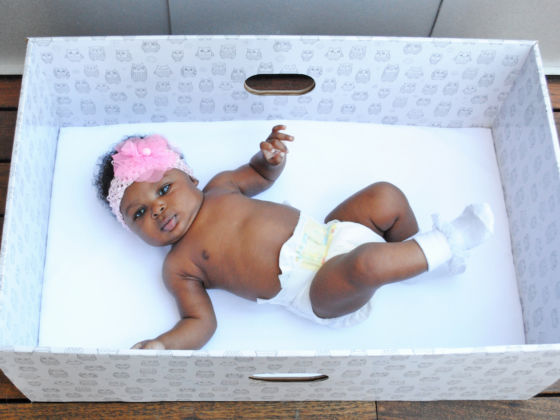IN 1938, Finland was worried about its high infant mortality rate (65 out of 1000 babies died in their first year) and wanted to remedy that by providing essential childcare supplies to new parents, so the Finnish social security institution Kela created the baby boxes, which contained sleeping gear, clothing, diapers, cleaning supplies, and a small mattress. The box itself was large enough to be used as baby’s first bed. The box still exists and though now new parents can trade the box for a flat fee of 140 Euros, 95% opt for the box (the items in it are worth substantially more.)

Finnish Baby Boxes Come to the United States. Here's Why It's Good News.
Finland’s child mortality rate dropped drastically after the introduction of the box (by 1958, only 20 years later, 25 in 1000 babies were dying) — especially since parents were required to visit a doctor or maternity clinic by their fourth month of pregnancy in order to get the baby box. Since prenatal care is one of the best ways to prevent preterm births and birth defects from lack of correct nutrients, getting new parents connected to Finland’s nascent socialized medical system was probably just as responsible for dropping the infant mortality rate as the boxes’ tiny snowsuits.
Scotland, India, South Africa and Canada have all jumped on the baby box bandwagon. Startups like Barakat Bundle offer free boxes, dependent on parents going for a prenatal check-up, to women in developing countries. Barakat Bundle and others operate with a focus on South Asian cultural context — and include a clean delivery kit.
The United States is also getting into baby boxes. Ohio, New Jersey, and Alabama are providing expectant mothers with boxes modeled on Finland’s, provided by a California-based company called The Baby Box Co. American parents cannot be required to visit a doctor, because without a system of socialized medicine in that country, a prenatal visit may not be financially viable. Nonetheless, many parents are enthusiastic about the box, which gives them a great step up into good quality care for newborns.
A small contained space with a firm mattress and no blankets or pillows, so that baby can’t accidentally get wedged into an adult mattress or trapped in the bars of a crib, seems like a good sleeping environment for babies. The boxes are also ideal for anyone who can’t afford a crib or bassinet. The boxes fit babies up to 6 months. Ohio, New Jersey, and Alabama are giving the boxes free to any parent who watches a video about best sleeping practices and completes a short quiz.
Experts say there isn’t enough research to tell if the boxes are good sleeping environments for babies, but the information and free supplies they give new parents are far better than nothing. Alabama’s infant mortality rate is 8.3 deaths per thousand births — among the worst in the country. The Alabama Rural Development Office estimates that, if every mother used the baby box, it would cut infant mortality by 22 percent.
Along with the three states mentioned above, hospitals in Philadelphia and San Antonio, Texas are also offering baby boxes to new parents. With any luck, infant mortality rates in the United States will continue to drop, as new parents receive access to information, supplies, and better healthcare for themselves and their babies.